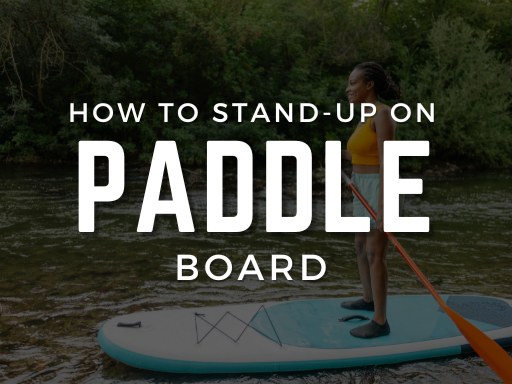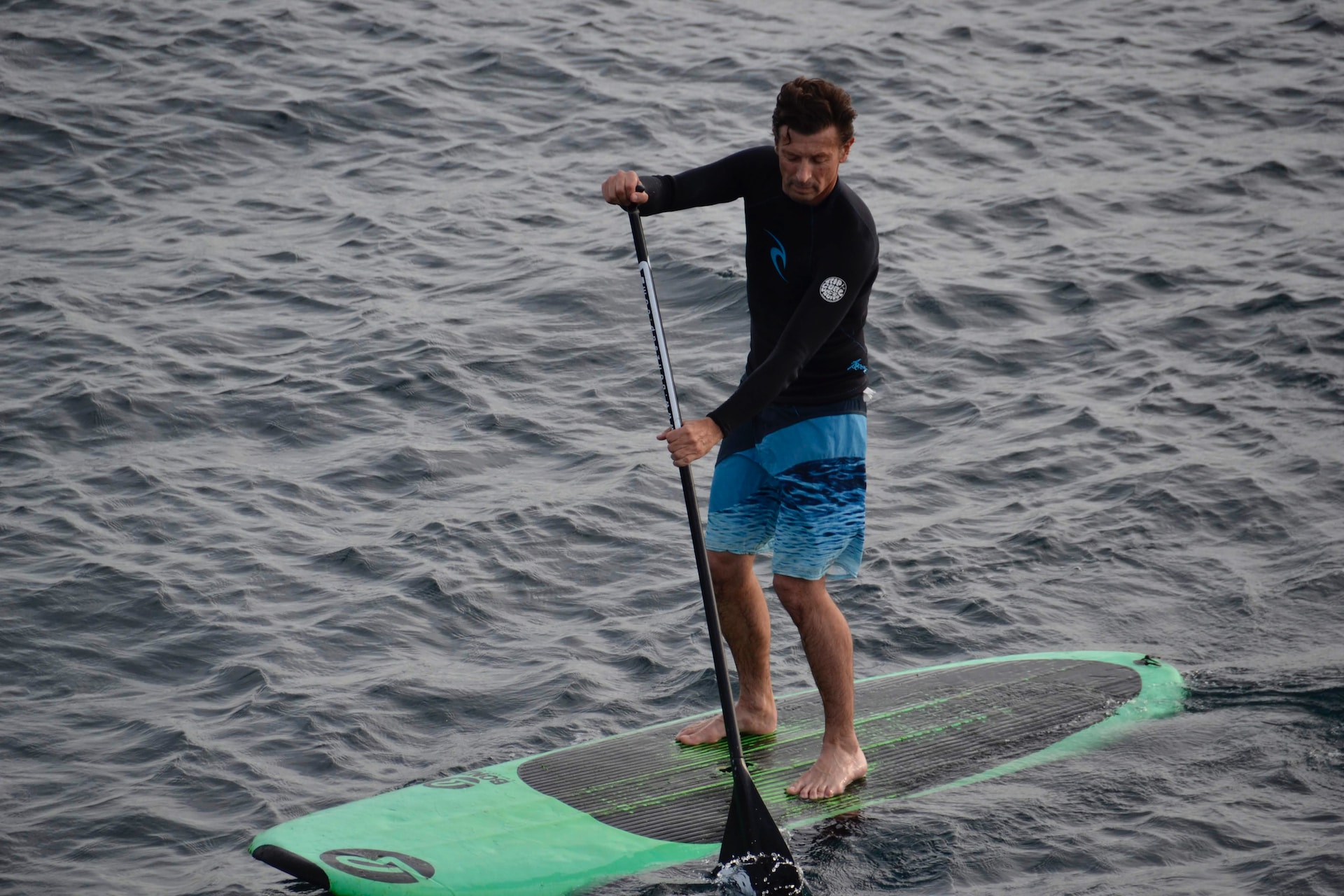To stand up on a paddleboard, position yourself in the middle, climb on, and kneel. Place feet where knees were, keep them hip-width apart, and slowly rise, using the paddle for balance.
Whether you’re a beginner or seeking to improve your technique, mastering the art of standing up on a paddleboard is the first step to an exciting aquatic adventure.
In this guide, we’ll break it down into simple steps. We’ll provide you with easy-to-follow instructions, so you can confidently go from kneeling to standing on your paddleboard.
Key Takeaways:
- Master paddleboard standing with this beginner’s guide.
- Prepare with the right gear, maintain balance, and explore advanced techniques, ensuring safety with PFD use and calm waters.

How To Stand Up On A Paddleboard?
Standing up on a paddleboard may seem challenging, but with the right technique, it’s easier than you think. Let’s learn step by step.
Step 1: Preparing to Paddleboard
Before you hit the water, it’s crucial to prepare. Choosing the right equipment can make or break your paddleboarding experience. Let’s dive into the essentials.
Choosing the Right Paddleboard
- Size Matters: Your height and weight dictate the size of the board you need. A larger board offers more stability, ideal for beginners. Smaller boards are agile but require more skill.
- Material Insights: Paddleboards come in various materials. Foam boards are affordable and durable, perfect for starters. Fiberglass and epoxy boards offer better performance but at a higher cost.
- Type of Board: For beginners, all-around boards are best. They are versatile and stable. If you plan to race or surf, specialized boards are available.
Essential Gear for Paddleboarding
- Paddle: An adjustable paddle is ideal. It should reach your wrist when you raise your arm above your head.
- Personal Flotation Device (PFD): Safety first. Always wear a PFD. It’s not just safe; in many areas, it’s the law.
- Leash: A leash keeps your board closed if you fall off. It’s a safety must-have.
- Proper Attire: Dress for the water temperature, not the air. Quick-dry clothing is recommended. In colder waters, consider a wetsuit.
Step 2: Getting into the Water
Now that you’re geared up, it’s time to enter the water. This step is all about finding the right spot and setting up your board correctly.
Selecting Your Paddling Spot
Calm, Shallow Water for Beginners
- Seek Calm Waters: For your first few tries, choose a spot with calm water. It makes learning easier.
- Shallow Areas: Start in shallow water. It should be deep enough to prevent the board from hitting the bottom, yet shallow enough for you to stand.
Board Positioning and Orientation
Positioning the Board Correctly
- Board Direction: The front of the board (the nose) is often pointed and sleek. The back (the tail) is wider.
- Place the Board: Gently place your board in the water. The fins should be in the back, not dragging on the bottom.
- Board Orientation: Ensure the board is facing the right direction. The fins should be trailing behind as you paddle.
By choosing a calm, shallow spot and positioning your board correctly, you create a safe and controlled environment for learning.
Step 3: The Basics of Standing Up
Mastering the stand-up technique is a pivotal moment in paddleboarding. Let’s break down the process into manageable steps.
Starting from a Kneeling Position
Moving from Kneeling to Standing
- Start Kneeling: Begin by kneeling in the middle of the board. Your knees should be on either side of the handle.
- Steady the Board: Keep your hands flat on the board for balance.
- Rising Up: Slowly move one foot at a time to where your knees were. Place your feet flat.
- Stand Up Slowly: With a straight back, rise to a standing position. Keep your knees slightly bent.
Finding the Sweet Spot
Locating and Positioning Your Feet
- The Sweet Spot: This is the board’s balance point. It’s usually near the center.
- Foot Placement: Place your feet parallel, hip-width apart. This stance offers the most stability.
- Balance Check: Shift your weight gently from foot to foot. Feel the board’s response.
By following these steps, you’ll transition smoothly from kneeling to standing. Finding the sweet spot helps maintain balance. Remember, patience and practice are key.
Final Step: Mastering the Stand-Up Technique
Once you’re up, the next challenge is to stay balanced and use your paddle effectively. These skills are crucial for a smooth paddleboarding experience.
Balancing on the Board
Maintaining Balance and Posture
- Keep Feet Parallel: Your feet should be hip-width apart, parallel to each other.
- Bend Your Knees: Slightly bending your knees aids in balance.
- Straight Back: Keep your back straight. This improves stability.
- Eyes Forward: Focus on the horizon, not your feet.
- Shift Weight Gently: To turn or adjust, shift your weight slowly. Avoid sudden movements.
Using the Paddle for Stability
Gripping and Using the Paddle
- Proper Grip: Hold the paddle with one hand on the top and the other on the shaft.
- Paddle Position: The paddle should be vertical when it enters the water.
- Smooth Strokes: Use long, smooth strokes. Pull the paddle back to your ankle, then lift it.
- Alternate Sides: To maintain a straight path, alternate paddling on each side.
By focusing on these techniques, you’ll enhance your balance and control.
Advanced Standing Techniques
As you grow more confident on your paddleboard, it’s time to explore advanced techniques. These skills will enhance your transitions and maneuvers.
Transitioning from Kneeling to Standing
- Start in a Stable Kneeling Position: Kneel in the middle of the board, hands on either side.
- Place Hands Forward: Move your hands in front of your knees for better support.
- Rise to a Crouch: Lift your body into a low crouch, keeping your back straight.
- One Foot at a Time: Slowly bring one foot forward, then the other, into a standing position.
- Gradual Rise: Stand up slowly, maintaining a low center of gravity.
Subsection 5.2: Adjusting Foot Position for Maneuvering
- Pivot Turn: Move one foot back towards the tail and shift your weight to turn quickly.
- Step Back for Sharp Turns: Stepping back on the board makes sharper turns easier.
- Lean Slightly for Speed: Lean forward slightly to increase speed, but maintain balance.
- Use Your Toes and Heels: Apply pressure with toes or heels to steer gently.
These advanced techniques require practice but offer greater control and agility on the water. With time, you’ll navigate your paddleboard with skill and confidence.
FAQs
Are There Specific Paddleboard Types Easier for Beginners?
Yes, all-around paddleboards are best for beginners. They are wider, offering more stability, which is crucial for learning. These boards are versatile, suitable for various conditions, and provide a balanced mix of stability, speed, and maneuverability.
Are There Any Safety Considerations When Standing Up on a Paddleboard?
Safety is key. Always wear a personal flotation device (PFD). Use a leash to keep your board attached. Start in calm, shallow water. Be aware of weather and water conditions. Avoid areas with heavy boat traffic or strong currents. Lastly, always inform someone about your paddling plan.
Final Words
Standing up on a paddleboard is a skill that opens the door to thrilling aquatic adventures. This step-by-step guide has equipped you with the essentials, from board selection to mastering advanced techniques.
By focusing on balance, posture, and paddle control, you’ll soon navigate the water with confidence. Remember to prioritize safety and practice regularly to enhance your paddle-boarding experience.


